When you approach St. Helena from the sea nothing could seem more forbiddingly inhospitable than the jagged cliffs and soaring crags that rise precipitously out of the frothing ocean, impenetrable ramparts that scream 'keep out.'
Black or dark grey with menace, the huge frowning folds of wrinkled volcanic rock give scant hint of the verdant lushness, microclimates and multiple landscapes hidden within this tiny 47-square-mile island lost in the vastness of the South Atlantic, 1,200 miles from Africa and 1,800 miles from Brazil.
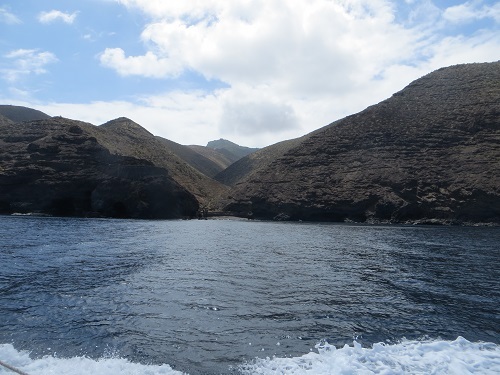
St. Helena's forbidding ramparts
This impregnable remoteness has made the island, with some 4,000 inhabitants, the very symbol of inaccessibility ever since Napoleon was exiled here in 1815.

Another view
You get your first inkling of something else in store when you step off the lighter that has brought you ashore and set foot in Jamestown, the capital. Only sparse vegetation breaks the monotony of the barren cliffs of the narrow ravine on either side. To the right of Main Street, the 699 steep, deep concrete steps of Jacob's Ladder scale the bare volcanic mass at a dizzying gradient of some 40 degrees.
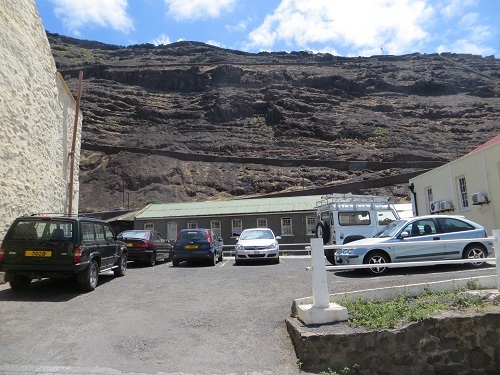
Downtown Jamestown in its barren ravine

Jacob's Ladder
But as you move on up Main Street, green and yellow vegetation on the hills at the end of the ravine catch your eye.
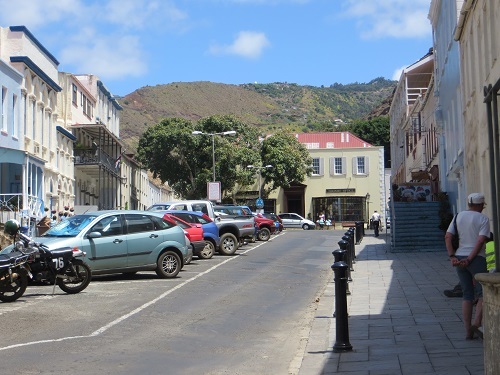
Looking up Main Street

Looking down on Jamestown
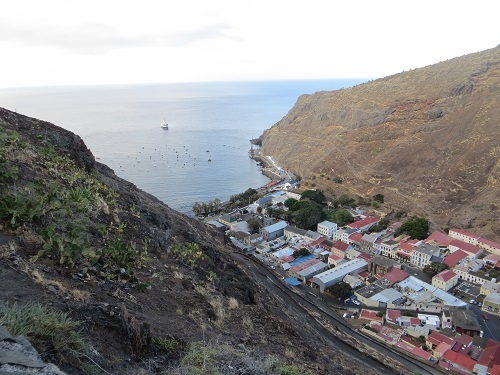
Another view
In a rental car, on a guided tour, or on foot - since this is a great place for energetic hiking along its many trails - you climb up the steeply snaking road out of Jamestown. Your first stop may be a vantage point overlooking the Heart-shaped Waterfall - mainly dry now because of a dam - its ridged red cliff face set off by plentiful patches of bright green and a backdrop of darker trees.
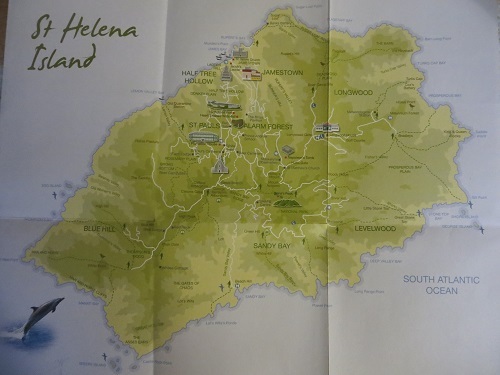
Map of St. Helena from government brochure
The amazing thing about St. Helena, which calls itself 'the most extraordinary place on Earth' in its tourist brochures, is the enormous differences in scenery and terrain in such a small piece of land that is 10 miles long and six miles wide at its greatest.
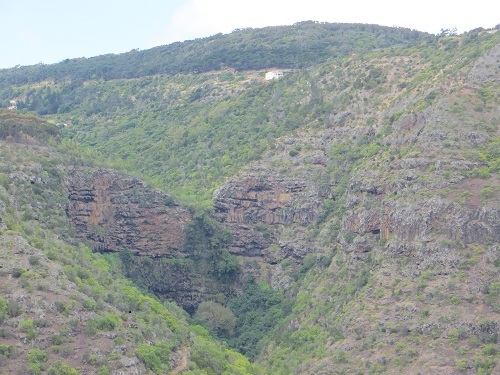
Heart-shaped Waterfall

Another view back to Jamestown
Turn a corner and in one minute you switch from a view of almost Alpine hills and forests to one of parched desert and desolation, to yet another of tier upon tier of rocks and cliffs like the giant waves of a petrified ocean, then back again to green lushness - sometimes two or more zones in the same glance of an eye.
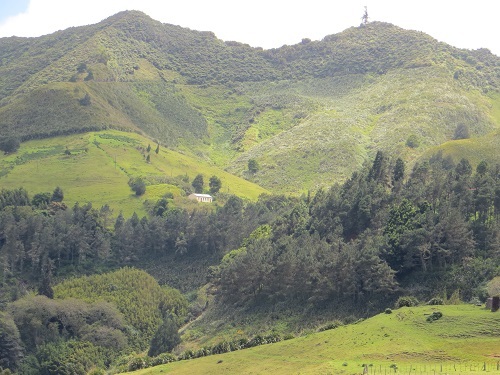
Meadows and woods
It is its steep altitude that gives St. Helena its great variety, with 2,690-foot Diana's Peak its highest point. Temperatures in the highlands are 10 degrees Fahrenheit lower than at the coast in Jamestown, where the thermometre can reach 90 in summer and drop to 59 in winter. The highlands also have greater rainfall and damp mists.
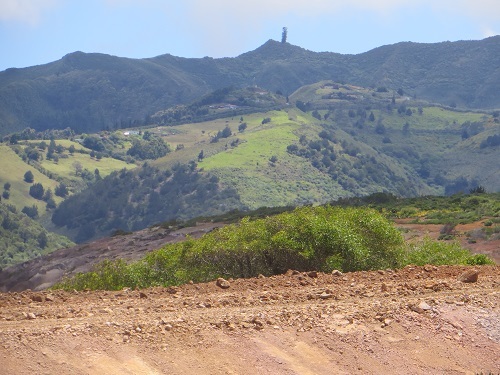
View towards Diana's Peak
The island, which rose out of the ocean 20 million years ago and last erupted 5 million years ago, has always had rich forests and other vegetation, but most of its endemic flora fell victim to European ship-builders and their sheep and goats after the Portuguese first sighted it in 1502.

Flowers on the meadow
Now many imported trees, including Norfolk Pine brought here by Captain James Cook and eucalyptus, and an array of flowers carpet the hillsides in bright hues, among them yellow Everlasting, descendants of a packet of seeds a British aristocrat, Lady Holland, sent to Napoleon out of pity for the ex-emperor's fall from grace. That single packet gained a Napoleonic complex of its own and has taken over much of the island.
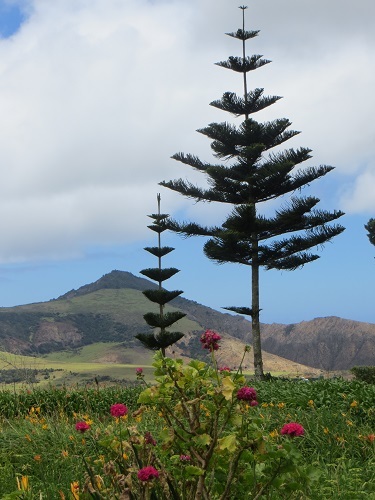
Flowers and trees
Moving higher beyond Heart-shaped Waterfall, you pass through such delightfully named places as Rosemary Plain, Lemon Valley, Mount Eternity, Horse Pasture and Scotland. Here flowers, brilliant purple and deep luminous orange, indigo, yellow, pink, red and blue, clothe trees and bushes, against a background of soaring green pastures, wooded mountainsides, and golden gorse-carpeted meadows.
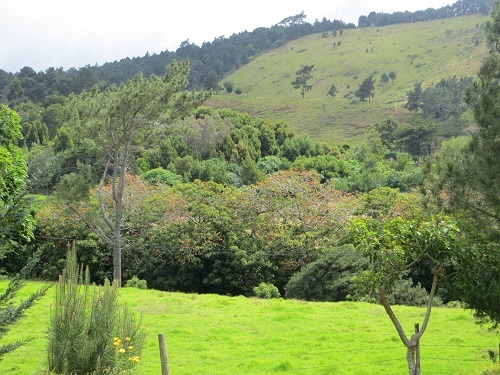
View from Rosemary Plain

Flowers at Farm Lodge
Yellow canaries, crimson-bellied red cardinals, white gulls and black and white mynah birds with orange-ringed eyes flit past, adding their flashes of colours.
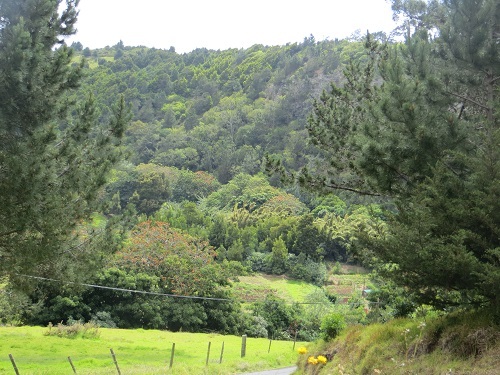
Another view
On a shrubby plateau white and brown wirebirds, the last remaining endemic bird species on the island, hop about with their chicks. Thus named for their spindly legs, they are being brought back from the brink of extinction as trappers catch the feral cats and rats who decimated them. They now number some 400.
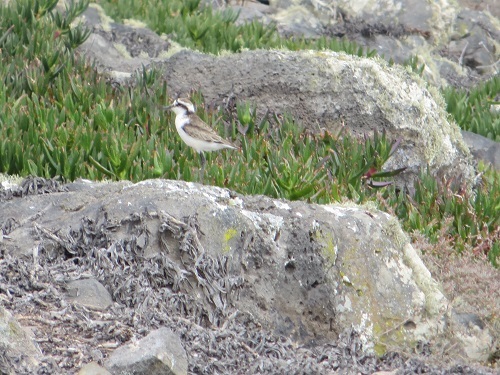
A wirebird

Flowers at a coffee plantation
At another turn, the tiny white church of St. Martin in the Hills overlooks lush green woods on one side. On the other a razor-sharp ridge cuts its jagged barren outline against a dark green mountain range.
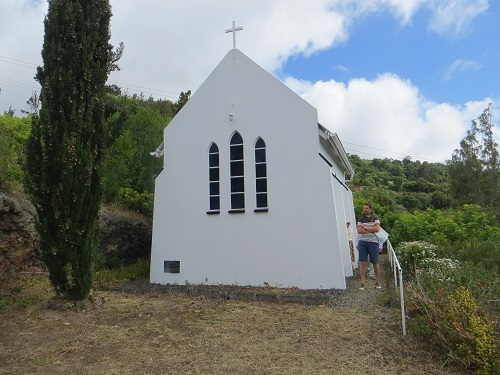
St. Martin in the Hills
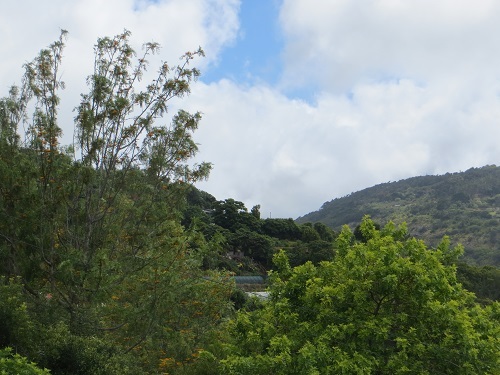
View from one side
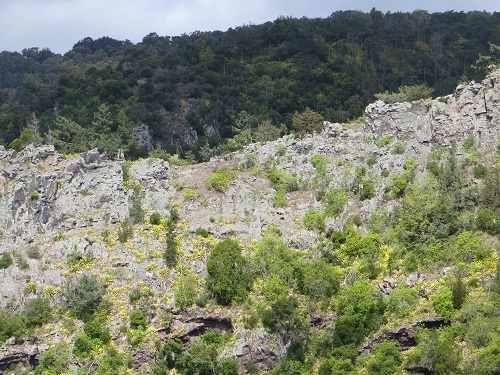
View from the other
Another short drive brings you to a hilltop view of Prosperous Bay Plain, a semi desert where the new airport is being built.
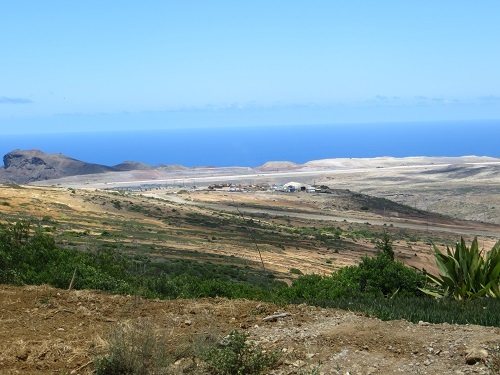
Semi-desert near airport
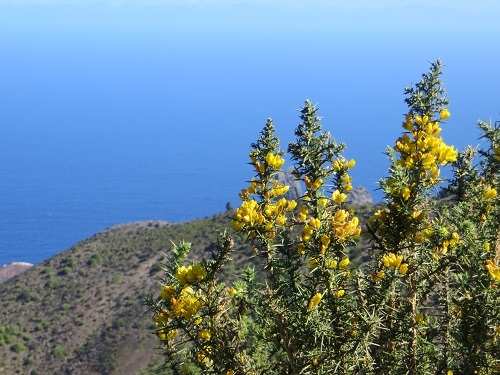
Flowers in the wilderness

Yet more flowers
Closer to Jamestown, you come to a gloriously luxuriant hollow that hosts Plantation House, the governor's residence, a large handsome Georgian mansion built in 1792.
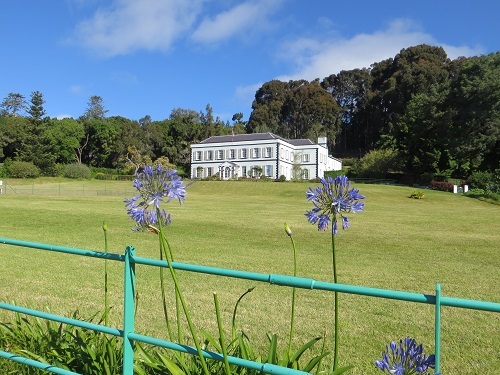
Plantation House
Bulbous blue flowers border one fence, the Union Jack flutters lackadaisically, and the House's most famous and distinguished resident, Jonathan - no, not His Excellency but a 180-year-old Seychelles tortoise - moves slowly across the lawn, his long thick leathery neck seeking grass.
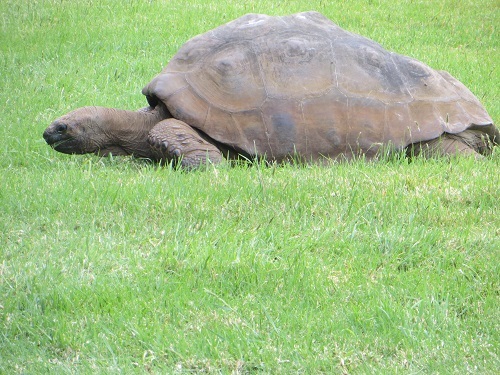
Jonathan
Vegetable allotments dot the slopes. Beyond, a narrow cove stretches out to the azure South Atlantic.
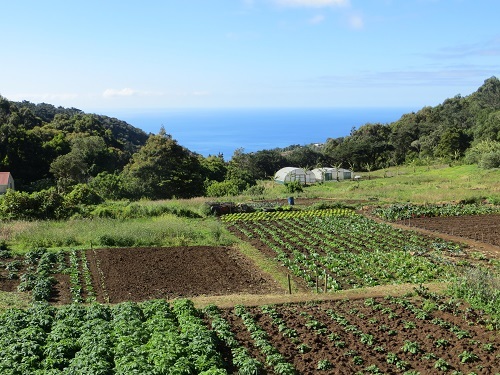
View from Plantation House
Yet one more short drive and the scenic kaleidoscope changes again. The brilliant green hill and roofs of Sandy Bay village glisten in the afternoon sun against a backdrop of a huge green-dusted monolith, a stormy sea of craggy ridges, and four jagged pinnacle tearing at the sky. Fields of deep green flax, brought from New Zealand, carpet the nearer hillsides.
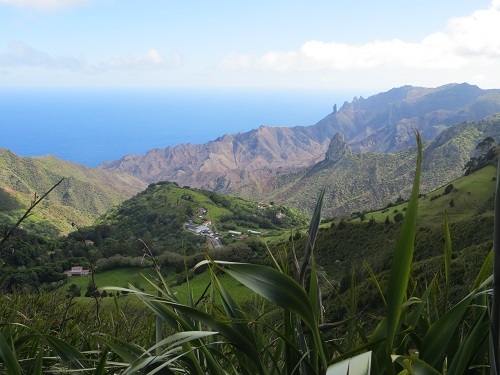
View over Green Hill, Lot and Lot's wife
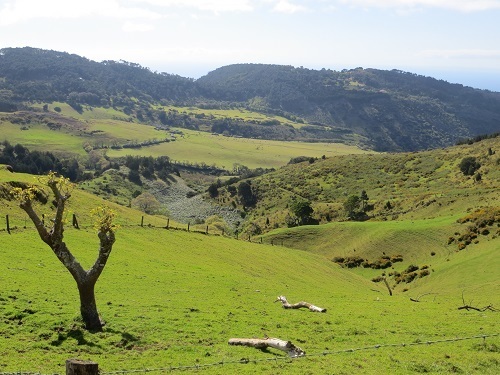
Nearby meadow
The monolith is called Lot, and the largest of the pinnacles Lot's Wife, turned to stone in the Bible for looking back on the destruction of Sodom and Gomorra. Turn around, and you're looking at the verdant splendor of Diana's Peak, flanked by two slightly lower wooded summits.
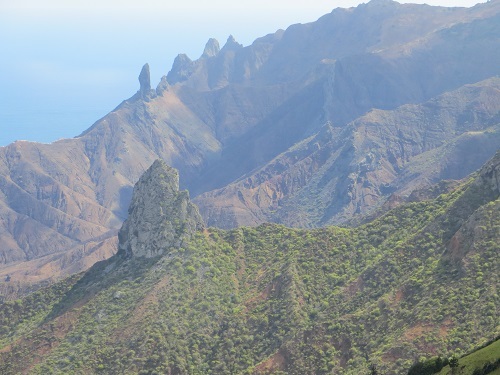
Closer look at Lot and his wife

And even closer
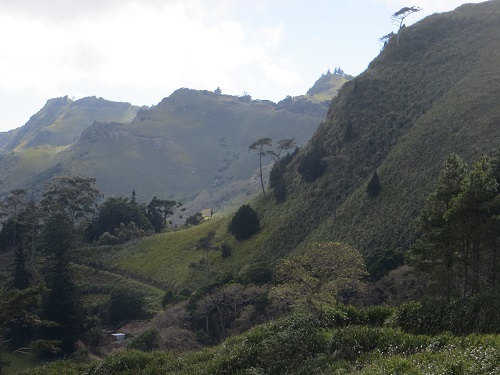
And the view towards Diana's Peak when you turn round
As you descend to Sandy Bay Beach, the landscape becomes totally barren, the blue ocean frothing and spraying against the dark black volcanic outcrops. The Gates of Chaos - massive crags on the razor sharp ridge above - loom over you, a scene worthy of Planet of the Apes.
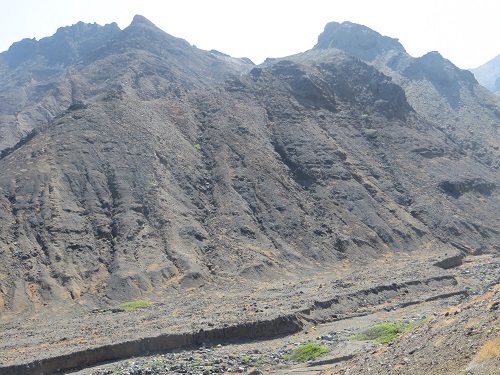
The Gates of Chaos
Rusty cannons from the defences of yore lie on the black sand, and the crumbling remnants of a stone and brick fort and walls recall the garrison of thousands that once guarded the island against an attempt by Napoleon to escape.

Sandy Bay Beach
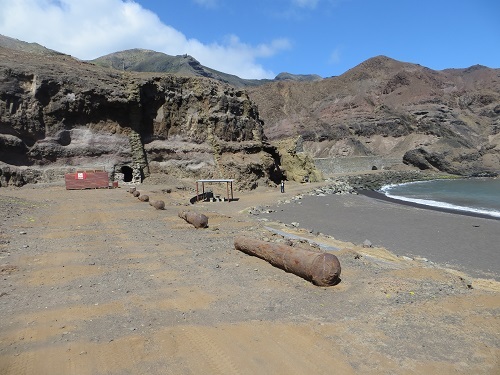
Abandoned cannons and remains of a fort of yesteryear
Turn inland again, and a lush patch of green with a few shining palm trees breaks the harsh bleakness of the craggy valley, a Biblical oasis in the wilderness. Even Jesus may walk past; that's the nickname of an antique farmer with a long white beard who is struggling on his way up the hill with his staff.
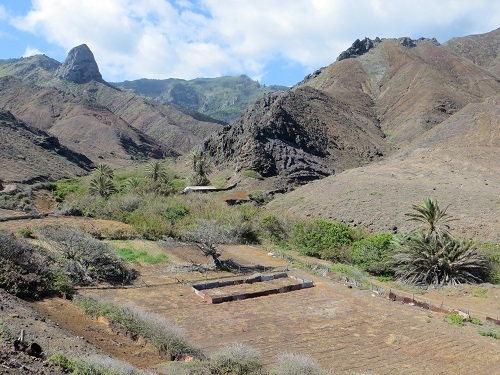
The little oasis in the wilderness
But if you go out to sea by boat, you're in for a shock. Lot's wife doesn't look like Lot's Wife any more. She looks like nothing so much as a two-headed circumcised penis.

OMG, Lot's Wife's been turned into a two-headed penis!
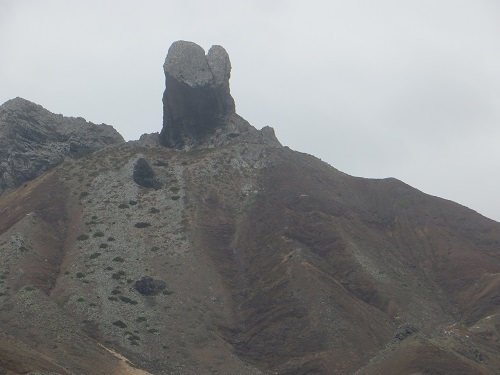
Now do you believe me?
______________
By the same author: Bussing The Amazon: On The Road With The Accidental Journalist, available with free excerpts on Kindle and in print version on Amazon.
Swimming With Fidel: The Toils Of An Accidental Journalist, available on Kindle, with free excerpts here, and in print version on Amazon in the U.S here.
from Travel - The Huffington Post http://www.huffingtonpost.com/mike-arkus/behind-the-barren-volcani_b_6297192.html?utm_hp_ref=travel&ir=Travel
Black or dark grey with menace, the huge frowning folds of wrinkled volcanic rock give scant hint of the verdant lushness, microclimates and multiple landscapes hidden within this tiny 47-square-mile island lost in the vastness of the South Atlantic, 1,200 miles from Africa and 1,800 miles from Brazil.

This impregnable remoteness has made the island, with some 4,000 inhabitants, the very symbol of inaccessibility ever since Napoleon was exiled here in 1815.

You get your first inkling of something else in store when you step off the lighter that has brought you ashore and set foot in Jamestown, the capital. Only sparse vegetation breaks the monotony of the barren cliffs of the narrow ravine on either side. To the right of Main Street, the 699 steep, deep concrete steps of Jacob's Ladder scale the bare volcanic mass at a dizzying gradient of some 40 degrees.


But as you move on up Main Street, green and yellow vegetation on the hills at the end of the ravine catch your eye.



In a rental car, on a guided tour, or on foot - since this is a great place for energetic hiking along its many trails - you climb up the steeply snaking road out of Jamestown. Your first stop may be a vantage point overlooking the Heart-shaped Waterfall - mainly dry now because of a dam - its ridged red cliff face set off by plentiful patches of bright green and a backdrop of darker trees.

The amazing thing about St. Helena, which calls itself 'the most extraordinary place on Earth' in its tourist brochures, is the enormous differences in scenery and terrain in such a small piece of land that is 10 miles long and six miles wide at its greatest.


Turn a corner and in one minute you switch from a view of almost Alpine hills and forests to one of parched desert and desolation, to yet another of tier upon tier of rocks and cliffs like the giant waves of a petrified ocean, then back again to green lushness - sometimes two or more zones in the same glance of an eye.

It is its steep altitude that gives St. Helena its great variety, with 2,690-foot Diana's Peak its highest point. Temperatures in the highlands are 10 degrees Fahrenheit lower than at the coast in Jamestown, where the thermometre can reach 90 in summer and drop to 59 in winter. The highlands also have greater rainfall and damp mists.

The island, which rose out of the ocean 20 million years ago and last erupted 5 million years ago, has always had rich forests and other vegetation, but most of its endemic flora fell victim to European ship-builders and their sheep and goats after the Portuguese first sighted it in 1502.

Now many imported trees, including Norfolk Pine brought here by Captain James Cook and eucalyptus, and an array of flowers carpet the hillsides in bright hues, among them yellow Everlasting, descendants of a packet of seeds a British aristocrat, Lady Holland, sent to Napoleon out of pity for the ex-emperor's fall from grace. That single packet gained a Napoleonic complex of its own and has taken over much of the island.

Moving higher beyond Heart-shaped Waterfall, you pass through such delightfully named places as Rosemary Plain, Lemon Valley, Mount Eternity, Horse Pasture and Scotland. Here flowers, brilliant purple and deep luminous orange, indigo, yellow, pink, red and blue, clothe trees and bushes, against a background of soaring green pastures, wooded mountainsides, and golden gorse-carpeted meadows.


Yellow canaries, crimson-bellied red cardinals, white gulls and black and white mynah birds with orange-ringed eyes flit past, adding their flashes of colours.

On a shrubby plateau white and brown wirebirds, the last remaining endemic bird species on the island, hop about with their chicks. Thus named for their spindly legs, they are being brought back from the brink of extinction as trappers catch the feral cats and rats who decimated them. They now number some 400.


At another turn, the tiny white church of St. Martin in the Hills overlooks lush green woods on one side. On the other a razor-sharp ridge cuts its jagged barren outline against a dark green mountain range.



Another short drive brings you to a hilltop view of Prosperous Bay Plain, a semi desert where the new airport is being built.



Closer to Jamestown, you come to a gloriously luxuriant hollow that hosts Plantation House, the governor's residence, a large handsome Georgian mansion built in 1792.

Bulbous blue flowers border one fence, the Union Jack flutters lackadaisically, and the House's most famous and distinguished resident, Jonathan - no, not His Excellency but a 180-year-old Seychelles tortoise - moves slowly across the lawn, his long thick leathery neck seeking grass.

Vegetable allotments dot the slopes. Beyond, a narrow cove stretches out to the azure South Atlantic.

Yet one more short drive and the scenic kaleidoscope changes again. The brilliant green hill and roofs of Sandy Bay village glisten in the afternoon sun against a backdrop of a huge green-dusted monolith, a stormy sea of craggy ridges, and four jagged pinnacle tearing at the sky. Fields of deep green flax, brought from New Zealand, carpet the nearer hillsides.


The monolith is called Lot, and the largest of the pinnacles Lot's Wife, turned to stone in the Bible for looking back on the destruction of Sodom and Gomorra. Turn around, and you're looking at the verdant splendor of Diana's Peak, flanked by two slightly lower wooded summits.



As you descend to Sandy Bay Beach, the landscape becomes totally barren, the blue ocean frothing and spraying against the dark black volcanic outcrops. The Gates of Chaos - massive crags on the razor sharp ridge above - loom over you, a scene worthy of Planet of the Apes.

Rusty cannons from the defences of yore lie on the black sand, and the crumbling remnants of a stone and brick fort and walls recall the garrison of thousands that once guarded the island against an attempt by Napoleon to escape.


Turn inland again, and a lush patch of green with a few shining palm trees breaks the harsh bleakness of the craggy valley, a Biblical oasis in the wilderness. Even Jesus may walk past; that's the nickname of an antique farmer with a long white beard who is struggling on his way up the hill with his staff.

But if you go out to sea by boat, you're in for a shock. Lot's wife doesn't look like Lot's Wife any more. She looks like nothing so much as a two-headed circumcised penis.


By the same author: Bussing The Amazon: On The Road With The Accidental Journalist, available with free excerpts on Kindle and in print version on Amazon.
Swimming With Fidel: The Toils Of An Accidental Journalist, available on Kindle, with free excerpts here, and in print version on Amazon in the U.S here.
from Travel - The Huffington Post http://www.huffingtonpost.com/mike-arkus/behind-the-barren-volcani_b_6297192.html?utm_hp_ref=travel&ir=Travel


0 comments:
Post a Comment